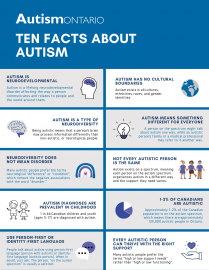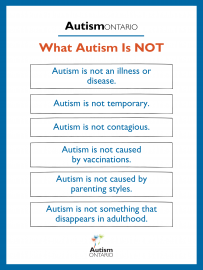About Autism
What is Autism?
The clinical model defines autism, or Autism Spectrum Disorder, as a lifelong neurodevelopmental disorder that affects the way a person communicates and relates to people and the world around them. It can affect body language and posture, social interactions and relationships, how you engage with your interests, and sensory processing capacities. Autism exists in all cultures, ethnicities, races, and gender identities.
While the Public Health Agency of Canada references the Diagnostic and Statistical Manual of Mental Disorders (DSM-5) in classifying autism as a disorder, many autistic people prefer the terms, neurological “difference” or “condition,” which remove the negative associations with the word, “disorder.” Being autistic means that your brain may process information differently than non-autistic, or neurotypical, people.
Autism exists on a spectrum, which means that while all people on the spectrum will experience some of the differences mentioned above, the degree to which each autistic person experiences them and the amount of support they need, will vary. This is sometimes influenced by whether the person on the autism spectrum has any co-occurring health conditions. It is also influenced by the accessibility and relative safety of the environment and society autistic people inhabit; a society that we all contribute to and live in.
For more information about autism, check out the Autism Self Advocacy Network’s (ASAN)online book, Welcome to the Autistic Community.
What Autism Isn't
Autism is not an illness or a disease.
Autism is not temporary.
Autism is not contagious.
Autism is not caused by vaccinations.
Autism is not caused by parenting styles.
Autism does not go away in adulthood.
How Many People in Canada Are on the Autism Spectrum?
In March 2018, the National Autism Spectrum Disorder Surveillance System (NASS) released the most up-to-date Canadian prevalence rate: 1 in 66 Canadian children and youth (ages 5-17) are diagnosed with Autism Spectrum Disorder (ASD). According to the Canadian Medical Association Journal, approximately 1 - 2% of the Canadian population is on the autism spectrum which means there are approximately 135,000 autistic people in Ontario.
As more research is being done on the intersections of autism and race, gender, sexuality, and social locations, more information is being made available online which is increasing the rates of autism diagnosis in children and adults. This in turn is placing a larger demand on education, healthcare, and social service systems, highlighting glaring gaps in the supports available; especially for autistic adults, people with lower incomes, people in rural areas, and Black, Indigenous, and people of colour.
Having these numbers helps us advocate to the appropriate government ministries for the individual needs of all people on the autism spectrum ;and their families throughout the life course.
Language Statement
Download a PDF version of our language statement.
At Autism Ontario, we recognize that language is powerful. We understand that the language we use can educate, frame ideas and perspectives, and empower, but that it can also harm and stigmatize[1]. The use of referential language as it relates to autism is a sensitive, important, ongoing conversation.
The clinical model defines autism, or Autism Spectrum Disorder, as a lifelong neurodevelopmental disorder that affects the way a person communicates and relates to people and the world around them. The Public Health Agency of Canada references the Diagnostic and Statistical Manual of Mental Disorders (DSM-5) in classifying autism as a disorder[2]. However, many autistic people prefer the terms neurological “difference” or “condition”, which remove the negative associations with the word “disorder”[3].
At Autism Ontario, our goal is to support and advocate alongside all autistic individuals across the province, regardless of race, ethnicity, income, religion, sexual orientation, or gender identity. We aim to actively and deliberately listen to and include all autistic community members to guide our choices relating to language.
We understand that many individuals in the autistic community prefer certain types of referential language[4], such as identity-first language (“autistic person” or “autist”) over person-first language (the terms “person with autism” or “person on the autism spectrum” are often used interchangeably).
Identity-first language reflects the belief that being autistic is an important part of a person’s identity. Person-first language, including phrases such as “living with autism”, reflects the idea that autism can be separated from a person. Results from a recent survey of over 7,000 autistic people suggest that approximately 90% of autistic people prefer identity-first language with a smaller proportion preferring person-first language[5]. According to the Canadian Autism Spectrum Disorder Alliance (CASDA), there is a growing body of scientific and community literature documenting the dislike, amongst autistic individuals, of person-first language and its potential for increasing stigma.[6] Disability scholars have also objected to the use of person-first language[7].
Although we acknowledge that there are varying beliefs within the autistic community about which language standards are ‘correct’, based on the existing literature on language preferences in the autistic community, Autism Ontario recommends using identity-first language (i.e., autistic person).
It is important to understand that each person may have a different preference for how they would like to be identified[8]. Autonomy and self-determination are the most important aspects to consider when talking about autism[9]. It is often best to ask an individual directly if they are comfortable telling you how they would prefer to be identified.
With the aim of being inclusive, respectful, and representative of the many people within our diverse community[10], we will use both identity-first and person-first referential language. We acknowledge that the use of language evolves rapidly and will continue to be an ongoing discussion within the autism community.
[4] https://healthjournalism.org/blog/2019/07/identity-first-vs-person-first-language-is-an-important-distinction
[5] https://healthjournalism.org/blog/2019/07/identity-first-vs-person-first-language-is-an-important-distinction
Additional References and Resources
Canada, Public Health Agency of. “Autism Spectrum Disorder among Children and Youth in Canada 2018.” Canada.ca, 19 Apr. 2018, www.canada.ca/en/public-health/services/publications/diseases-conditions/autism-spectrum-disorder-children-youth-canada-2018.html.
Furfaro, Hannah. “Conditions That Accompany Autism, Explained.” Spectrum, 7 May 2020, www.spectrumnews.org/news/conditions-accompany-autism-explained/.
Holmans, Christa. “What IS Autism? – The Whole Person Model or the Differences Model (Book Preview).” Neurodivergent Rebel, 28 Feb. 2020, neurodivergentrebel.com/2020/02/25/what-is-autism-the-whole-person-model-or-the-differences-model-book-preview/.
“Language Guide.” CASDA, 11 July 2020, www.casda.ca/language-guide-2/.
“Welcome to the Autistic Community.” Welcome to the Autistic Community!, autismacceptance.com/read-the-book/.
Four Directions Autism (a parent-to-parent support group for First Nations, Inuit, and Metis parents who have autistic children): http://fourdirectionsautism.ca/index.html


